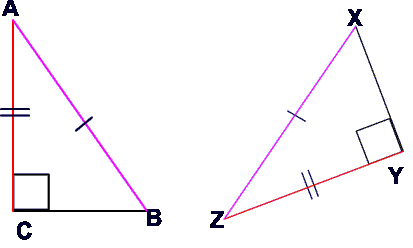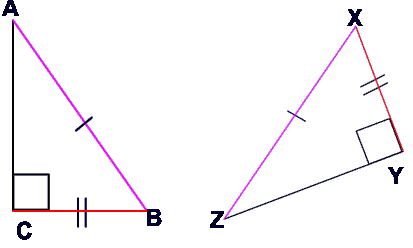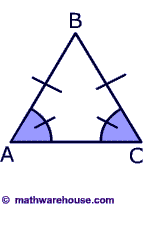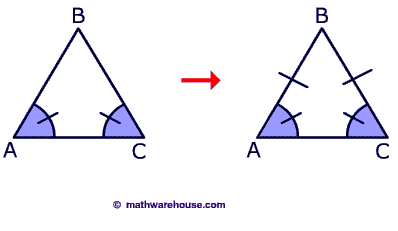Meaning of triangles
A triangle is one of the basic shapes of geometry: a polygon with three corners or vertices and three sides or edges which are line segments. A triangle with vertices A, B, and C ...
Math for Morons Like Us - Geometry: Congruent Triangles ... Parallel Lines Congruent Tri. Congruent R. Tri.
A triangle is a polygon with three sides. There are of course triangles of different shapes and sizes. The applet below show triangles of many shapes and sizes.
Triangle (geometry)
Encyclopedia Article
Article Outline
Introduction; Plane Triangles; Spherical Triangles
| | Introduction |
y), geometric figure consisting of three points, called v
ertices, connected by three sides. In Euclidean plane ge
ometry, the sides are
straight line segments (see Fig. 1
). In spherical geometry, the sides are arcs of great circl
es (see Fig. 2). See Geometry; Trigonometry. The term triangle is sometimes used to d
escribe a geometric fi
gure having three vert
ices and sides that are arbitrary curves (see
Fig. 3).
An angle A is acute if 0° < a =" 90°;">
A triangle is scalene if no two of its sides are equal in length, as in Fig. 1; isosceles if two sides are equal, as in Fig. 6; and equilateral if all three sides are equal, as in Fig. 7. The side opposite the right angle in a right triangle, HK in Fig. 5, is called the hypotenuse; the other two sides are called legs. The two equal sides of an isosceles triangle are also called legs, and the included angle is called the vertex angle. The third side is called the base, and the adjacent angles are called the base angles.
If two sides of a triangle are of unequal size, the angles opposite are of unequal size; the larger side is opposite the larger angle. In the same way, if two angles are unequal, the sides opposite are unequal. Therefore, the three angles of a scalene triangle are of different sizes; the base angles of an isosceles triangle are equal; and the three angles of an equilateral triangle are equal (an equilateral triangle is also equiangular). The side opposite a right angle or an obtuse angle is the longest side of the triangle. see Trigonometry: Law of Sines for the exact relation between the sizes of the angles and sides of a triangle.
In any triangle, an altitude is a line through a vertex perpendicular to the opposite side or its extension, for example, DX in Fig. 8a and 8b. A median is the line determined by a vertex and the midpoint of the opposite side, AN in Fig. 9. An interior angle bisector is the line through a vertex bisecting the interior angle at the vertex, AR in Fig. 10; similarly, an exterior angle bisector bisects the exterior angle at the vertex, AV in Fig. 10. A perpendicular bisector is a line perpendicular to a side at its midpoint, HK in Fig. 11. The terms altitude, median, and interior angle bisector are also often applied to the line segment determined by the vertex and the intersection with the opposite side or its extension.
The three altitudes of a triangle meet in a common point called the orthocenter, O in Fig. 8a and 8b. The three medians meet in a point called the centroid, M in Fig. 9. The centroid divides a median through it into two segments, and the segment having a vertex as endpoint is always twice as long as the other segment. The three angle bisectors meet in a point called the incenter (I in Fig. 10), and the three exterior angle bisectors meet in three points called the excenters, U, V, W of Fig. 10. The incenter and the three excenters are centers of circles tangent to the sides or side extensions of the triangle. The three perpendicular bisectors meet in a point called the circumcenter, H in Fig. 11, which is the center of a circle passing through the three vertices.
If a, b, c are the three sides of a triangle, and ha is the altitude through vertex A, the semiperimeter s is given by the formula s = y (a + b + c), and the area K by the formula K = yaha = ÅÆÇÈÇÉÊ. Many other formulas interrelate the various parts of a triangle.
- Vertical angle Theorem Proofs
Vertical Angle Theorem: If two angles are vertical angles, then they have equal measures.
| Statements/Conclusion | Justification |
| 1) | 1) Given |
| 2) | |
| 3) | |
| 4) | |
| 5) m | |
| 6) m | |
| 7) m | |
| 8) m |
* Step 7 is usually not necessary and is only included for clarification.
· Postulates
Angle Side Angle Postulate
Proving Congruent Triangles with ASA
The Angle Side Angle postulate (often abbreviated as ASA) states that if two angles and the included side of one triangle are congruent to two angles and the included side of another triangle, then these two triangles are congruent.
Theorems and Postulates for proving triangles congruent
Hypotenuse Leg Theorem | Side Side Side | Side Angle Side | Angle Side Angle | Angle Angle Side |isosceles triangle proofs|CPCTC | indirect proof| quiz on all theorems/postulates
Example of Angle Side Angle Proof
![]() ABC
ABC ![]()
![]() XYZ
XYZ
- Two angles and the included side are congruent
 CAB =
CAB =  ZXY (angle)
ZXY (angle) - AB = XY (side)
 ACB =
ACB =  XZY (angle)
XZY (angle) - Therefore, by the Angle Side Angle postulate (ASA), the triangles are congruent.
Included Side
The included side means the side between two angles. In other words it is the side 'included between' two angles.
Side Angle Side Postulate
Proving Congruent Triangles with SAS
- Two sides and the included angle are congruent
- AC = ZX (side)
 ACB =
ACB =  XZY (angle)
XZY (angle) - CB = ZY (side)
- Therefore, by the Side Angle Side postulate, the triangles are congruent.
 ABC
ABC  XYZ
XYZ 
Side Side Side Postulate
Proving Congruent Triangles with SSS
Example 1
- Alll 3 sides are congruent
- ZX = CA (side)
- XY = AB (side)
- YZ = BC (side)
- Therefore, by the Side Side Side postulate, the triangles are congruent.
 ABC
ABC  XYZ
XYZ 
Angle Angle Side Postulate
Proving Congruent Triangles with AAS
- Two angles and a non-included side are congruent
 CAB =
CAB =  ZXY (angle)
ZXY (angle)  ACB =
ACB =  XZY (angle)
XZY (angle)- AB = XY (side)
- Therefore, by the Angle Angle Side postulate (AAS), the triangles are congruent.
 ABC
ABC  XYZ
XYZ 
Hypotenuse Leg Theorem
Proving Congruent Right Triangles
Example 1
Given AB = XZ, AC = ZY,
Prove
 ABC and
ABC and  XZY are right triangles since they both have a right angle
XZY are right triangles since they both have a right angle- AB = XZ (hypotenuse) reason: given
- AC = ZY (leg) reason: given
 ABC
ABC 
 XYZ by the hypotenuse leg theorem which states that two right triangles are congruent if their hypotenuses are congruent and a corresponding leg is congruent.
XYZ by the hypotenuse leg theorem which states that two right triangles are congruent if their hypotenuses are congruent and a corresponding leg is congruent.

Given AB = XZ, CB = XY,
Prove
 ABC and
ABC and  XZY are right triangles since they both have a right angle
XZY are right triangles since they both have a right angle- AB = XZ (hypotenuse) reason: given
- CB = XY (leg) reason: given
 ABC
ABC 
 XYZ by the hypotenuse leg theorem which states that two right triangles are congruent if their hypotenuses are congruent and a corresponding leg is congruent.
XYZ by the hypotenuse leg theorem which states that two right triangles are congruent if their hypotenuses are congruent and a corresponding leg is congruent.

CPCTC
Corresponding parts of congruent triangles are congruent
- 'corresponding parts of congruent triangles are congruent'
Please click this link for further explanation
Isosceles Triangle Proofs
Theorems and practice
Isosceles Triangle

An isosceles triangle has two congruent sides and two congruent angles. The congruent angles are called the base angles and the other angle is known as the vertex angle.
Isosceles Triangle Theorems
The Base Angles Theorem
If two sides of a triangle are congruent, then the angles opposite those sides are congruent.Converse of the Base Angles Theorem
The converse of the base angles theorem, states that if two angles of a triangle are congruent, then sides opposite those angles are congruent.











No comments:
Post a Comment